Bitcoin OG Willy Woo has sold most of his Bitcoin: Here’s why
Veteran Bitcoiner Willy Woo has done the unthinkable and cashed out most of his stack.
Ive sold most of my Bitcoin now, the legendary onchain analyst cheerfully tells Magazine.
But what on earth possessed the industrys best-known onchain analyst to give up on the hardest money known to man? Has he gone mad?
It turns out that Woo believes he can make more money selling shovels during the gold rush, than buying gold, with most of the proceeds of his Bitcoin sales reinvested into Bitcoin infrastructure.
The co-founder of crypto quant fund Crest explains that Bitcoins market capitalization is around $2 trillion, which means it probably has at best 50x growth to $100 trillion, which he believes will be near the ceiling.
Woos thesis is that early-stage Bitcoin startups have the potential for even better returns from here on in.
If you were to look at a Bitcoin venture, youve got, you know, a good venture is 100 to 1,000x return, he says.
And even if they crash and burn, many infrastructure firms still offer indirect exposure to Bitcoin through their Bitcoin holdings.
If theyre not successful, theyre holding Bitcoin. So it de-risks that investment, he says.
It just makes sense that smart money would go into Bitcoin infrastructure. It is now the picks and shovels series.
Where is Bitcoin at right now, Mr Woo?
That said, Woo still keeps a close eye on Bitcoins price and says market participants are overestimating Bitcoin because of a misunderstanding of current price action.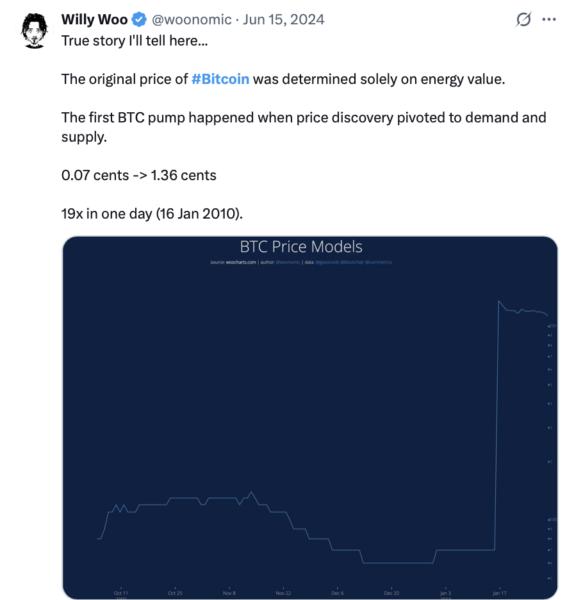
Even though Bitcoin recently reached new all-time highs, Woo has a theory about why the price hasnt been climbing as fast as people expected, despite billions being snapped up every week by treasury companies and Bitcoin ETFs.
Theres a lot of OGs that are systematically selling into every bull market, he says.
Woo says when Bitcoin OGs sell Bitcoin they bought for under $1,000 at, say, $100,000, nearly all of that money, $99,000, is coming from new buyers.
That means a lot of new capital is needed just to handle their selling.
Itll take time for this capital to come in, and immense amounts of capital to rotate the cheap buyers out, he says.
The bullish part is that with Bitcoin breaking into price discovery this week, it suggests the money is indeed flowing in, and the OG sellers are drying up.
Who is Willy Woo?
Born in Hong Kong and raised in New Zealand, Woo has developed a reputation as the best onchain analyst in Bitcoin since buying his first Bitcoin in 2013. Hes since built up a following of over 1.1 million on X thanks to his widely respected insights.
This interview had been a long time coming for Magazine. We first reached out to Woo in early 2024 and had an initial conversation, during which Woo respectfully shared his reasons for staying away from interviews.
He had stepped away from being a Bitcoin and crypto X celebrity to start a family and spend time with his kids. There was also an unwelcome increase in real-world recognition.
Oh, are you really Woo? he recalls being asked more than once out in public.
At one point, someone bumped into me, and they said, ‘Oh, how old is your daughter?’ he says, adding that he was even asked one time what school she attended.
Then suddenly youve got toddlers around and everythingI just felt like I wanted privacy for my family, he adds.
I thought that the last cycle my profile got probably more reach than I wanted. And I just wanted to cool it down a bit.
It definitely wasnt how he imagined things would go when he first immersed himself in the Bitcoin industry after randomly stumbling into a local Bitcoin meetup in Bali back in 2014.
He was quickly orange-pilled and helped to run the local Bitcoin event in Bali, even challenging himself to show up each time with a fresh topic to share.
Over the years, Woo developed several of Bitcoins well-known onchain valuation metrics. 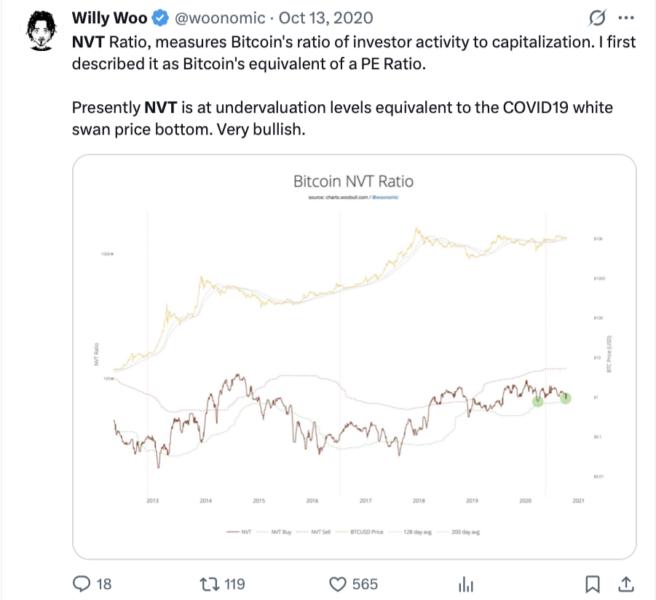
One he is best known for, the Network Value to Transactions (NVT) ratio which compares Bitcoins market cap to its transaction volume was created back in early 2017 after being asked on social media what the closest thing to a price-to-earnings ratio would be for Bitcoin, given that it isnt a company.
After creating the NVT ratio, Woo started getting noticed in the global Bitcoin industry.
Crypto news outlets began reporting on his posts on X more often, which made his follower count climb even faster
Then in 2021, he introduced the Supply Shock valuation model, which he used to correctly predict that years Bitcoin rally to $55,000.
His website is loaded with charts and metrics now widely used in the Bitcoin industry, creatively named Woo Charts.
Woos strategic move may not be for everyone
So Woo probably knows what hes doing with his decisive pivot toward Bitcoin venture projects.
Im investing in things that long-term will benefit the Bitcoin cohort.
Read also FeaturesLegal issues surround the FBI’s creation of fake crypto tokens
FeaturesInside South Koreas wild plan to dominate the metaverse
But before you start dreaming about quitting your job and doing likewise, Woo warns that investing in these kinds of projects is not easy. You have to be strategic for the startup to bring you onto the investment cap table, he says.
The valuations are very low, typically between four and 20 million for the whole value, and hopefully it becomes a unicorn, he adds.
The payoff can be massive. One big winner for Woo was the crypto wallet provider Exodus Wallet. In 2016, they did a crowdfunding. I had a seed round in there, and it was the only wallet that had a really good UX at the time, and it had a good business model as well, he says.
Exodus raised $4 million in the round and listed on the NYSE American in December 2024 and now trades at a market cap of just under a billion dollars.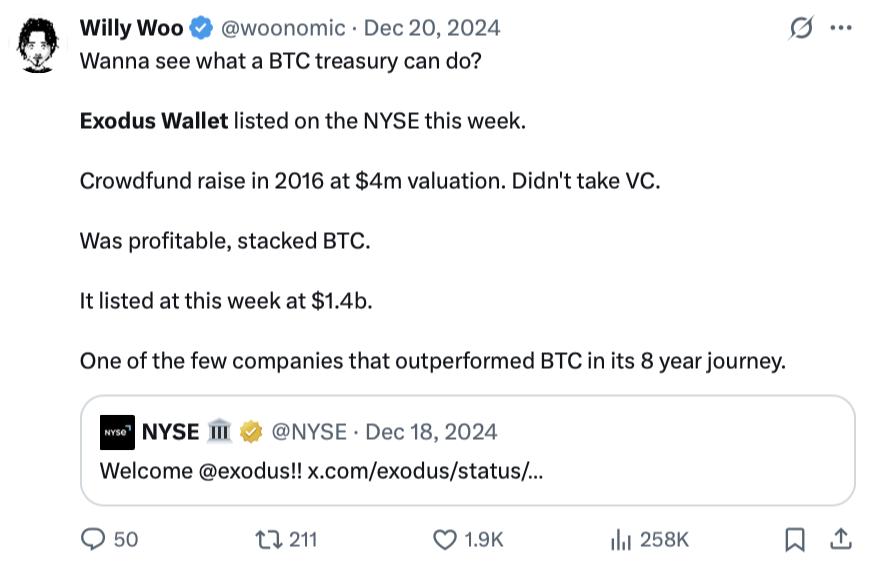
It wasnt always true that early crypto projects were better investments than Bitcoin. Woo says that if you had invested in Coinbases early funding rounds in 2012, the returns by its 2021 IPO would have been underwhelming compared to simply holding Bitcoin over the same period.
You would underperform Bitcoin by 50%, like you would have lost half your Bitcoin, he says.
Bitcoin was growing so strong in those early days. But today its more reliable to outperform Bitcoin with a venture, he adds.
Woo is also happier not having to self-custody a huge stack of Bitcoin anymore. Once people know youve got Bitcoin, that becomes a security issue, he says.
In a way, its a return to Woos roots, as he was investing in early ventures before Satoshi Nakamoto even introduced cryptocurrency in 2009. Ive been in the startup space since way before Bitcoin, and I like investing in the next generation of founders, he adds.
Bitcoin treasury company boom is like the 2017 ICO bubble
Woo isnt a fan of Bitcoin treasury companies, although hed take a position in Michael Saylors Strategy during a bull market.
Ive stepped aside from a lot of this treasury stuff, like the latest wave reminds me of the 2017 ICO bubble, with insiders getting the early access and so forth, he says.
I think a lot of them will have issues on the bear side, he says. Hes not alone in thinking this, with Glassnode lead analyst James Check recently sharing that his instinct is the Bitcoin treasury strategy has a far shorter lifespan than most expect.
Read also Features Blockchain detectives: Mt. Gox collapse saw birth of Chainalysis Features Decade after Ethereum ICO: Blockchain forensics end double-spending debateWoo recently invested in Bitcoin lending platform Debifi, which allows Bitcoiners to keep hold of their private key while borrowing fiat.
The big core part of their technology is a multi-key hardware sort of escrow for all the parties, he says.
I like it, because it very much promotes self-custody, he says before admitting that sounds hypocritical given he is no longer a self-custody guy.
Woo says he has no problems with a diverse group of companies holding assets on his behalf.
Each company has a wallet with probably more security practices than a single person would ever have, even if theyre good at it.
Woo is skeptical of Bitcoin getting ridiculous amount of FOMO
Woo doesnt think retail investors are going to pile in and push Bitcoin to ludicrous new heights any time soon.
Im not entirely convinced that were going to get this ridiculous amount of FOMO, he says.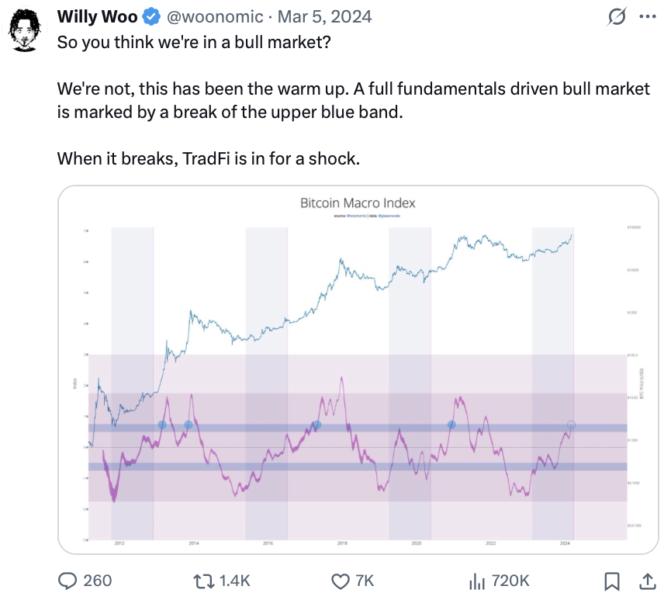
Even if they came in all at once, he questions how much of a difference it would really make. Does retail have the, you know, the multiple billions per day to make a difference? he says.
Obviously, Michael Saylor has been like the biggest impact right now with his close to 600,000 Bitcoin stack, very quickly, he says.
$1M Bitcoin is pretty pessimistic lower bound
When asked about when Bitcoin will reach $1 million, Woo says people need to be clear whether thats in todays dollars or future dollars.
I would like to know first, is that like inflation-adjusted? he says.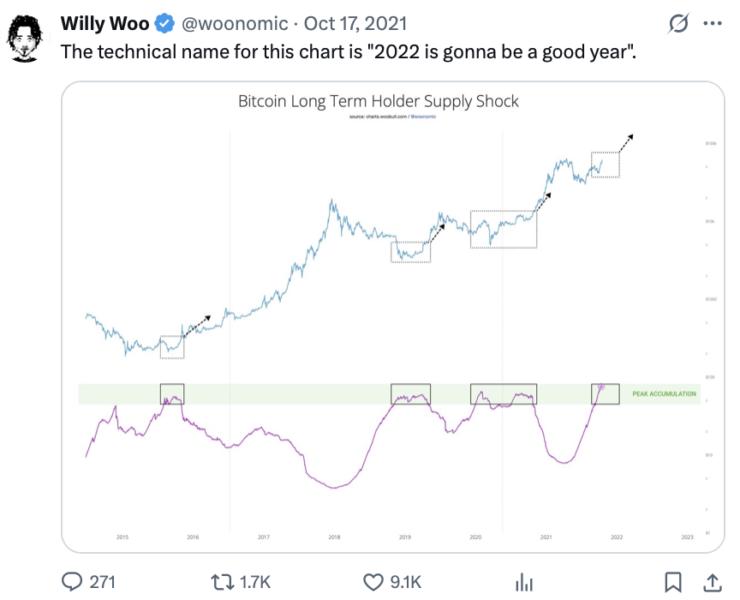
Woo says that with inflation, a $1 million Bitcoin price in 10 years really just means $500,000 in todays money.
When we go long range, I think we have to say, is that todays money or tomorrows money? he says.
But Woo confidently predicts that in the next 10 to 20 years, Bitcoin will be trading between $1 and $10 million in todays value.
I think five is probably a nice sweet spot, he says, adding that $1 million would be pretty pessimistic lower bound.
Subscribe The most engaging reads in blockchain. Delivered once a week.Email address
SUBSCRIBE